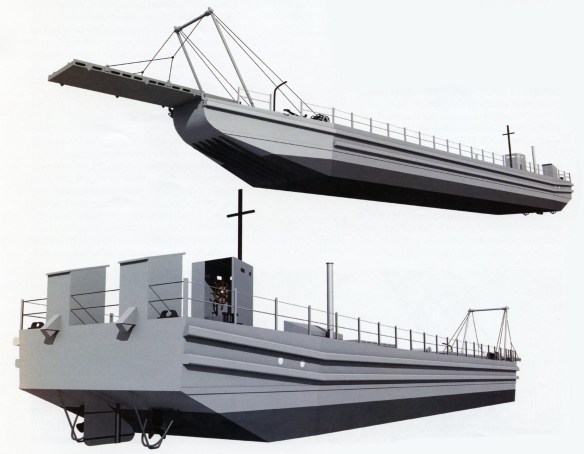A number [100] of large purpose-built `X Lighters’ had been developed by the Navy in the First World War and these contributed to the landings at Suvla Bay in 1915.
Although something of a military sideshow, the campaign at Gallipoli also made a contribution to the acceptance of the internal combustion engine for marine use. Anticipating the need to land troops and equipment on beaches here and elsewhere, the British Admiralty ordered large numbers of small landing craft. To ensure a shallow draught, these X-lighters were fitted with lightweight motors, many being hot-bulb engines. After the war, these X-lighters were sold off and many were converted for commercial use, giving some British coastal shipowners their first experience of the motor vessel.
The search for a more suitable landing craft continued after the war and this requirement was consistently emphasised in exercise reports. In the 1920s an inter-service Landing Craft Committee was established to study the design and number of craft required to conduct a landing on a hostile shore. Their first attempt at a landing craft was the Motor Landing Craft (MLC(1)) completed in 1926. This craft was not a success and was followed in 1928 by the MLC(10). The MLC(10) was a flat-bottomed craft powered by a water jet. It could embark 100 troops or a 12-ton tank, discharging them directly onto the beach via a steep bow ramp. The water jet gave it a relatively slow speed of only 5 knots and the boat’s flat bottom and bow ramp made it rather unseaworthy, handicaps that are common in modern amphibious craft. By 1934 the MLC had been thoroughly tested in a series of exercises and the design proved satisfactory. Two more vessels were procured and these were joined by six more, ordered as a result of the 1936 Abyssinian crisis.
X-Lighters in WWI and at Gallipoli
X Lighters
| Displacement | 200 tons |
| Dimensions | 105ft 6″ x 21 x 7ft 6″ |
| Guns | Unarmed (The crew may have had side arms for self-defence or covering fire on the beaches) |
| Machinery | steam or diesel engines, speed 8 kts |
| Crew | 4 |
| Builders | various |
| Laid Down | 1915 |
| Completed | 1915- 18 |
